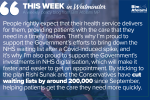The below is an analysis of the broad macro-economic situation, rather than a political statement. I will be setting out my views of how the Government needs to respond to some of these problems in the coming weeks.
Central banks and interest rates
For the last 15 years central banking has been about supporting growth and heading off deflation. Today they face the opposite problem – too much growth and rising inflation. The Federal Reserve broke the last great surge of inflation, in the early 1980s, by raising interest rates to 19%, in the process inducing a recession. Today’s situation is different, not least because inflation rates are lower and, unlike the 1970s, inflation has been subdued for years, due to a mixture of sensible policy and China’s integration into world markets. But there are enough similarities – soaring energy prices, tight labour markets and industrial unrest – for the 1980s experience to be relevant and unsettling today.
It is my view that central banks, including the Bank of England, have been slow to appreciate the scale of the inflationary threat. As recently as last summer they were suggesting that interest rates would stay at low levels for years to come, even though it was obvious that the problems storing up in the system meant that the risks of high inflation were rising sharply. I wrote about this in Conservative Home in September 2021 – (https://www.conservativehome.com/thecolumnists/2021/09/bim-afolami-after-the-reshuffle-back-to-the-future-nhs-queues-rising-energy-bills-and-higher-prices.html).
Things have changed. Last week the Fed raised rates by 0.75%, the largest increase in 28 years, and an implicit acknowledgement that the pace of rate increases so far had been too slow. The Bank of England raised rates at last Thursday’s meeting, the fifth consecutive meeting at which they have done so. On the same day the Swiss central bank raised Swiss rates for the first time in 15 years. Christine Lagarde, head of the European Central Bank, confirmed that euro area rates would increase in July and went further by saying rates would probably go up again in September and beyond.
The message from central banks is that inflation is rising faster than they expected – and that they are determined to get things under control. Financial markets expect a barrage of interest rate rises in the next six months. Markets see UK rates rising from a current 1.25% to around 3.0% by the end of 2022 before peaking at about 3.5% in 2023. US rates are forecast to rise from the current 1.5%–1.75% to 3.5% by the end of 2022 with euro rates rising from -0.5% to almost 1.25%. 2022 is likely to witness the sharpest tightening of monetary policy since the 1980s.
What does this all mean? Higher inflation and higher rates spell slower growth. 44% of US business economists surveyed by The Wall Street Journal expect the US to fall into recession in the next 12 months. In the UK the Bank of England is forecasting that the UK economy will show low growth in the next 6 - 12 months.
Energy and supply chains
In Europe, the problem of energy supplies is rising up the political agenda as governments start to heed the warnings of electricity generators and the fuel distribution industry. All of a sudden, pipelines and LNG supplies have risen up the National Grid’s agenda and it would seem that even the regulators have woken up to the complex issues of landing Natural Gas in the UK and distributing it. The regulation and regulators involved in electricity generation and distribution make decision-making more difficult as any change to the status quo is usually viewed as risky.
The aftermath of Covid and the unwinding of the supply chain bottlenecks means that a huge quantity of goods is clearing through the ports in the US and Europe, and arriving in retail warehouses and shops. Produce that should have arrived for late winter and spring seasons is arriving at the same time as goods needed for summer and the coming autumn. This is coinciding with a downturn in retail sales as customers tighten their belts to afford the rapidly increasing prices of food and fuel. The disruption in supply chains over the last two years, added to the sanction regimes triggered by the Russian invasion of Ukraine, as well as causing supply chaos, is creating confusing statistical economic numbers, making most predictions even more unreliable than usual.
The good news is also adding confusion to economic statistics as businesses react to the supply chain problems. The manufacturing sector is ramping up production and re-shoring production from Asia. Well-run businesses are investing in advanced manufacturing. One can expect to see increased productivity and a reduction in the reliance on imports, particularly in areas like food – e.g. we launched our national food strategy last week.
China’s policy of locking down whole cities in the face of Covid instead of a meaningful vaccination program is going to make its recovery considerably more difficult. President Xi has to find a way of getting out of the lockdown policy, but moving China’s bureaucratic supertanker onto a new course will be slow. As that situation gradually improves it will start to reduce global inflation, as the supply chain difficulties will be eased for companies that are still fully integrated with China.
Though much of the above seems gloomy, I believe that the next few months are probably going to see the bottoming of the downward economic cycle. Things will pick up soon. The uptrend will take many people by surprise as economies embrace new technologies which are growing rapidly but do not appear in economic data. The most fascinating statistic to look at is the supply of semiconductors, now above pre-Covid levels and growing rapidly. Understanding where they are going will give an insight into the technology revolution that is starting to unfold.
Copyright 2024 Bim Afolami Conservative Candidate for Hitchin. All rights reserved.
Powered by Bluetree

